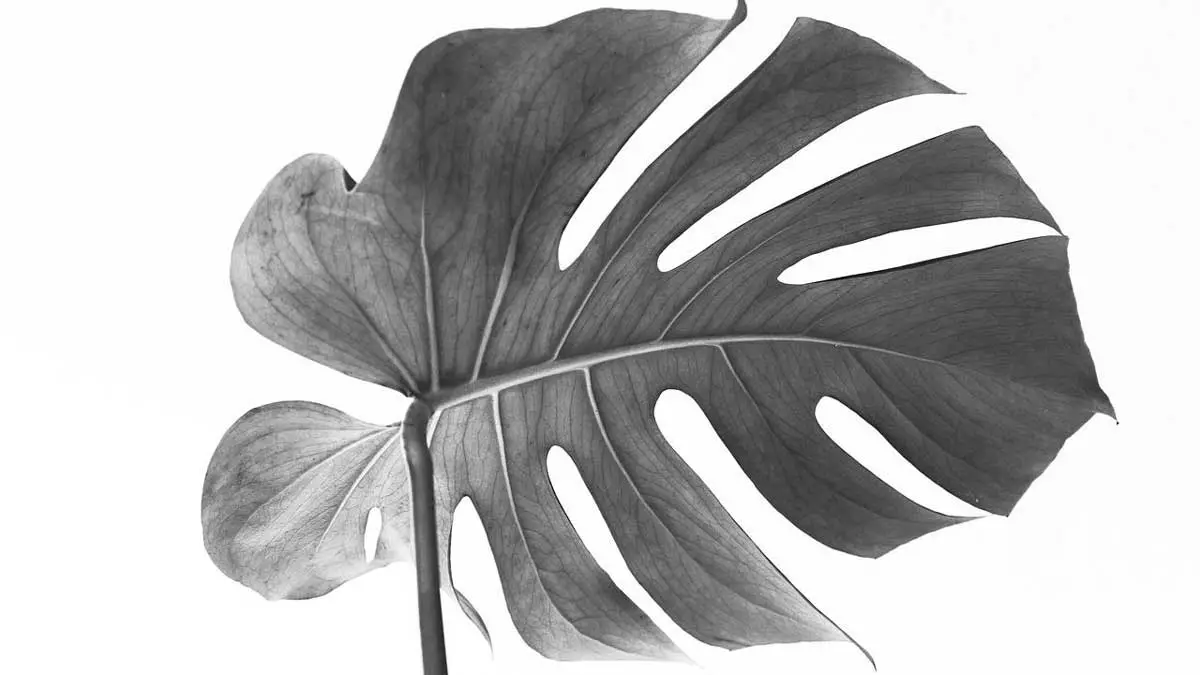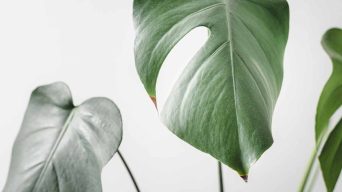Monstera plants are known for their large, glossy leaves, making them popular for indoor and outdoor gardens.
However, sometimes these leaves can develop black spots or even turn black entirely.
While this may be alarming for gardeners, there are a few different reasons why Monstera leaves might turn black, and most of them are relatively easy to fix.
Here are some of the most common causes of black leaves on Monstera plants and what you can do to treat them.
Why Are My Monstera Leaves Turning Black and How Can You Fix It?
There are a few different reasons why Monstera leaves might turn black.
You need to determine the cause to know how to treat it effectively.
Here are some of the most common causes of black leaves on Monstera plants:
1. Overwatering
Overwatering is one of the most common reasons Monstera leaves turn black.
Monstera plants like to have their roots kept moist but not soggy.
If you water your plant too often or allow the roots to sit in water, this can cause the leaves to turn black.
If a Monstera plant receives excessive watering, its roots may become deprived of essential oxygen, potentially resulting in the darkening of leaves and their eventual demise.
You can tell if your Monstera plant is being overwatered if the leaves are wilting or yellowing in addition to turning black.
How To Fix It
If you think your Monstera is overwatered, you should check the root system first.
If the roots are mushy or black, this is a sign of root rot, and your plant will need to be replanted in fresh, well-draining soil.
You can save your plant if the roots are healthy by watering it less often.
Allow the top inch or two of the soil to dry out before watering again.
2. Sunburn
Monstera plants are native to the tropical rainforests of Central and South America, which means they are used to living in shady, dappled light.
They thrive in bright indirect sunlight and can even tolerate some low-light conditions.
However, the leaves can sunburn if they are suddenly exposed to direct sunlight.
You can tell if the leaves are blackened or crispy if your plant is sunburned.
How To Fix It
If you think your Monstera is sunburned, move it to a location that receives indirect or filtered light.
If possible, place it in an east-facing window where it will get morning light but be protected from the harsh afternoon sun.
You can also try to protect your plant from the sun by placing a sheer curtain over the window or using a grow light.
3. Pest Infestation
Monstera plants are susceptible to pests like mealybugs, aphids, and scale insects.
Mealybugs are small, white insects that feed on plant sap, which can cause the leaves to turn black.
Aphids are small, green, or black insects that feed on plant sap.
Scale insects are small, brown, or black bugs that attach to plant stems and leaves and suck out the sap.
These pests can cause your plant’s leaves to turn black by sucking out the sap or introducing harmful toxins.
You can tell if your plant has pests by looking for small, crawling insects on the stems or undersides of the leaves.
You might also see sticky honeydew or black sooty mold on the leaves.
How To Fix It
If you think your Monstera has pests, you can try to remove them by hand or with a soft cloth.
You can also use a mixture of water and dish soap to kill the pests.
Be sure to spray the undersides of the leaves where the pests are likely to hide.
You can also try using organic pesticides, such as neem oil or horticultural oil.
This will help to kill the pests and prevent them from coming back.
4. Fungal and Bacterial Diseases
Monstera plants can also be susceptible to fungal and bacterial diseases, such as Leaf spot, Anthracnose, Black spot, and Leaf Blights.
These diseases are caused by fungi or bacteria that enter the plant through wounds or natural openings, such as the stomata.
Once inside the plant, the fungi or bacteria can reproduce and spread, causing the leaves to turn black.
You can tell if your plant has a fungal or bacterial disease if you see black or brown spots on the leaves.
The leaves might also be yellowing, wilting, or falling off.
Leaf Spot
Leaf spot is a bacterial disease that appears as brown or black spots on the leaves, often with a yellow halo.
The Leaf spot disease is caused by too much moisture from rain, watering, or humid conditions.
Anthracnose
Anthracnose is a fungal disease that can affect Monsteras.
It appears as sunken, dark spots on the leaves and is caused by too much moisture and can be spread by water droplets.
Black Spot
Black spot is a fungal disease that appears as black spots on the leaves.
Humid conditions cause it and can be spread by water droplets.
Leaf Blights
Leaf blights are fungal diseases that cause the Monstera leaves to turn yellow, brown, or black.
These diseases are caused by too much moisture and can be spread by water droplets.
How To Fix It
If you think your Monstera has a fungal or bacterial disease, first, you need to remove the affected leaves.
You should also ensure that your plant gets enough ventilation and that the leaves are dry before watering.
Watering from below can help to prevent the spread of fungal diseases.
You should also avoid overhead watering, as this can promote the growth of fungal diseases.
You can also try using a fungicide or bactericide but follow the instructions carefully.
5. Fertilizer Burn
Fertilizer burn is a common problem with Monstera plants.
It occurs when the plant’s roots are burned by too much fertilizer.
Fertilizer burn appears as black or brown spots on the leaves and can be caused by over-fertilizing, using the wrong type of fertilizer, or fertilizing too often.
How To Fix It
If you think your Monstera has fertilizer burn, stop fertilizing it and flush the roots with water to remove any excess fertilizer.
You can then replant the Monstera in a fresh, clean potting soil.
Be sure to use a light hand when fertilizing in the future and only fertilize when the plant is actively growing.
6. Frost Damage
Frost damage is another common problem with Monstera plants.
It occurs when the leaves are damaged by cold temperatures, usually below 50 degrees Fahrenheit.
Frost damage manifests as dark or brownened markings on the foliage and can be caused by exposure to cold weather or drafts.
How To Fix It
If your Monstera has frost damage, move it to a warmer location.
You should bring the plant indoors if the temperature outside is below 50 degrees Fahrenheit.
You can also try using a grow light to provide additional warmth or cover the plant with a sheet or blanket to protect it from the cold.
7. Root Rot
Root rot is a common problem with Monstera plants.
It occurs when the plant’s roots are damaged by too much water.
Root rot appears as black or brown spots on the Monstera leaves and can be caused by overwatering, using contaminated water, or planting in poorly drained soil.
How To Fix It
If your Monstera has root rot, stop watering it and allow the roots to dry out.
You can then replant the Monstera in fresh soil.
Be sure to use well-drained soil and only water when the soil is dry.
8. Chemical Build-Up
Chemical build-up is another common problem with Monstera plants.
It occurs when chemicals damage the leaves in the water or soil.
Chemical build-up appears as black or brown spots on the leaves and can be caused by using tap water, using fertilizers or pesticides, or planting in contaminated soil.
Using tap water is the most common cause of chemical build-up in Monstera plants.
The chemicals in tap water can damage the leaves and cause them to turn black or brown.
How To Fix It
If you think your Monstera has chemical build-up, you should stop using tap water and switch to filtered or distilled water.
If you can’t use filtered or distilled water, you should allow the tap water to sit for 24 hours before using it. This will allow the chemicals to evaporate before you use it on your plant.
You should also use a light hand when fertilizing and only when the plant is actively growing.
Flubbing the roots with water would be best to remove any excess chemicals.
You can then replant the Monstera in a fresh, clean potting mix.
Clean the leaves of your Monstera with a soft, damp cloth to remove any build-up of chemicals.
9. Physical Damage
Physical damage is another common problem with Monstera plants.
It occurs when the leaves are damaged by physical means, such as being bruised or scratched. When damaged, the leaf tissue breaks and turns black or brown.
This damage is usually caused by improper handling, accidental knocking the plant over, high winds, or heavy rains.
Pests, such as caterpillars or snails, can also cause damage.
How To Fix It
If you think your Monstera has physical damage, you should inspect the plant for signs of pests.
You should also check the leaves for any bruises or scratches.
If you find any, you should remove the damaged leaves.
You can also try to protect the plant from further damage by moving it to a sheltered location.
10. Heat Stress
Heat stress is another common problem with Monstera plants.
It occurs when the leaves are damaged by high temperatures, usually above 90 degrees Fahrenheit.
Exposure to high temperatures causes the plant to lose water faster than it can replace it, causing the leaves to turn black or brown.
How To Fix It
If you think your Monstera has heat stress, move it to a cooler location.
You can also try to increase the humidity around the plant by misting it with water or using a humidifier.
You should also ensure the plant has plenty of ventilation to prevent it from getting too hot.
11. Drought Stress
Drought stress is another common problem with Monstera plants.
It occurs when the leaves are damaged by a lack of water.
When the plant doesn’t have enough water, the leaves will start to turn black or brown.
How To Fix It
If you think your Monstera has drought stress, you should water it immediately.
Water the plant until the soil is saturated and water starts draining from the pot’s bottom.
You should then allow the soil to dry out completely before watering again.
You can also try to increase the humidity around the plant by misting it with water or using a humidifier.
How To Prevent Monstera Leaves From Turning Black Or Brown
The best way to prevent Monstera leaves from turning black or brown is to provide the plant with the proper care.
Here are some tips to help you care for your Monstera:
- Place the plant in an area where it will receive bright indirect light. Monstera leaves will burn if placed in direct sun for extended periods.
- Water the plant regularly and evenly. Allow the soil to dry out between watering sessions.
- Ensure that the plant has good drainage. Monstera plants are susceptible to root rot, so using a pot with drainage holes and a well-draining potting mix is essential.
- Fertilize the plant every two weeks during the growing season. Use a balanced fertilizer that is low in nitrogen.
- Humidity is important for Monstera plants. If the air in your home is too dry, consider placing the plant on a pebble tray or using a humidifier.
- Monstera leaves can develop brown or black spots if exposed to drafts. Ensure the plant is not near an air conditioner, heater, or fan.
- Repot the plant every two years. Use a well-draining potting mix and a pot that is slightly larger than the root ball.
- Prune the Monstera plant as needed to control its size. Remove brown or yellow leaves as they occur.
Following these tips will help you keep your Monstera healthy and prevent the leaves from turning black or brown.
Final Thoughts
Your Monstera leaves turning black could be caused by several different things.
Overwatering is the most common cause, which can lead to fungal infections or root rot.
Other causes could be too much direct sunlight or pests.
Fortunately, most of these problems can be fixed with patience and care.
Start by examining your plant and try to identify the root of the problem.
Once you know what’s causing the leaves to turn black, you can take steps to fix the issue.
With time and effort, you can get your Monstera back to its healthy self in no time!







